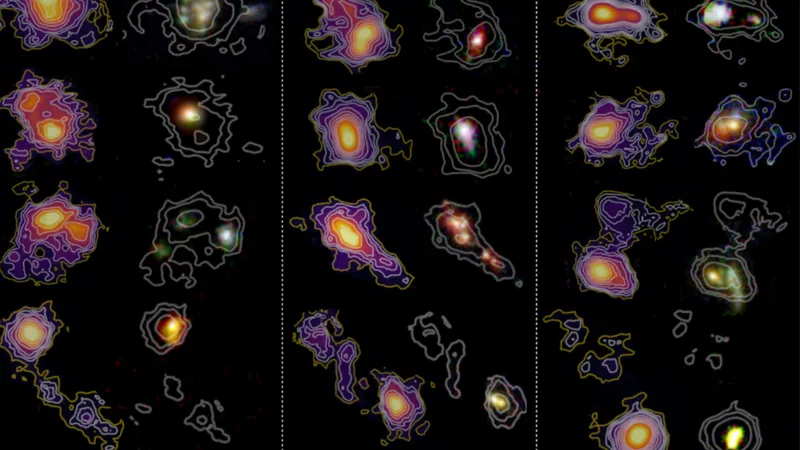
Unlocking the Universe's Secrets: Astronomers Use 'Time Machine' to Discover Hidden Structures in Early Galaxies
2025-07-07
Author: Wei
A Cosmic Journey Back in Time
In a groundbreaking study, astronomers have harnessed the power of the Atacama Large Millimeter/submillimeter Array (ALMA) to create a celestial time machine. This extraordinary tool allows scientists to peek back into the cosmos just 1 billion years after the Big Bang, unveiling previously hidden structures within the universe's earliest galaxies.
Revolutionary Insights from the CRISTAL Survey
The revelations come from the CRISTAL survey—an acronym for [CII] Resolved ISM in Star-forming galaxies with ALMA. By focusing on 39 representative star-forming galaxies from the universe's infancy, researchers have been able to illuminate how the intricate tapestry of the cosmos, including our very own Milky Way, began to take shape.
Rodrigo Herrera-Camus, principal investigator of the CRISTAL project, expressed excitement about the findings. "Thanks to ALMA's unique sensitivity and resolution, we can resolve the internal structure of these early galaxies in ways never possible before," he stated. The data highlights how nascent galactic disks formed, stars clustered in massive groups, and gas reactions shaped the galaxies we witness today.
Revealing the Hidden Structures
The impressive findings were made possible by ALMA's ability to detect a specific emission from ionized carbon atoms within cold interstellar gas, known as [CII] line emission. This data is a crucial tracer of the cold gas and dust that permeates galaxies.
By mapping interstellar gas, scientists discovered vast clumps of star formation spread over thousands of light-years. Notably, the [CII] emissions extended far beyond the stars of many targeted galaxies, suggesting vast reservoirs of cold gas ready to form new stars or being expelled by the powerful winds of newborn stars.
Galaxies on the Verge of Evolution
Among the findings, some CRISTAL galaxies displayed signs of rotational movement, hinting at their eventual evolution into disk-shaped structures, which are precursors to spiral galaxies like our Milky Way.
Loreto Barcos-Muñoz, a member of the research team, shared the excitement of witnessing these early galaxies as dynamic ecosystems rather than mere points of light. "The CRISTAL project demonstrates how ALMA reveals the internal structure of distant galaxies, showcasing their interactions, evolution, and star formation processes."
Two Exceptional Galaxies Discovered
Among the 39 galaxies studied, two stood out for their unique characteristics. CRISTAL-13 is concealed by massive clouds of dust that obscure its visible light emissions but allow ALMA to detect its hidden formations.
CRISTAL-10 presents an intriguing mystery. Its faint ionized carbon emissions suggest extreme conditions within its interstellar medium, possibly pointing to significant energy-producing phenomena.
Pioneering the Future of Cosmic Exploration
Sergio Martín, head of science operations at ALMA, noted the potential of this powerful observatory. "These observations highlight ALMA’s role as a time machine, letting us explore the universe's early days. Programs like CRISTAL unleash the full potential of ALMA's capabilities to answer pressing questions about cosmic evolution."
The CRISTAL survey doesn’t just illuminate aspects of cosmic history; it lays the groundwork for future explorations that could unravel how the chaotic early galaxies transformed into the orderly structures we observe in the modern universe.
In the words of Herrera-Camus, "CRISTAL provides multi-wavelength data enabling us to refine our theories of galaxy evolution. This is a significant leap toward comprehending how galaxies such as our Milky Way originated."


 Brasil (PT)
Brasil (PT)
 Canada (EN)
Canada (EN)
 Chile (ES)
Chile (ES)
 Česko (CS)
Česko (CS)
 대한민국 (KO)
대한민국 (KO)
 España (ES)
España (ES)
 France (FR)
France (FR)
 Hong Kong (EN)
Hong Kong (EN)
 Italia (IT)
Italia (IT)
 日本 (JA)
日本 (JA)
 Magyarország (HU)
Magyarország (HU)
 Norge (NO)
Norge (NO)
 Polska (PL)
Polska (PL)
 Schweiz (DE)
Schweiz (DE)
 Singapore (EN)
Singapore (EN)
 Sverige (SV)
Sverige (SV)
 Suomi (FI)
Suomi (FI)
 Türkiye (TR)
Türkiye (TR)
 الإمارات العربية المتحدة (AR)
الإمارات العربية المتحدة (AR)